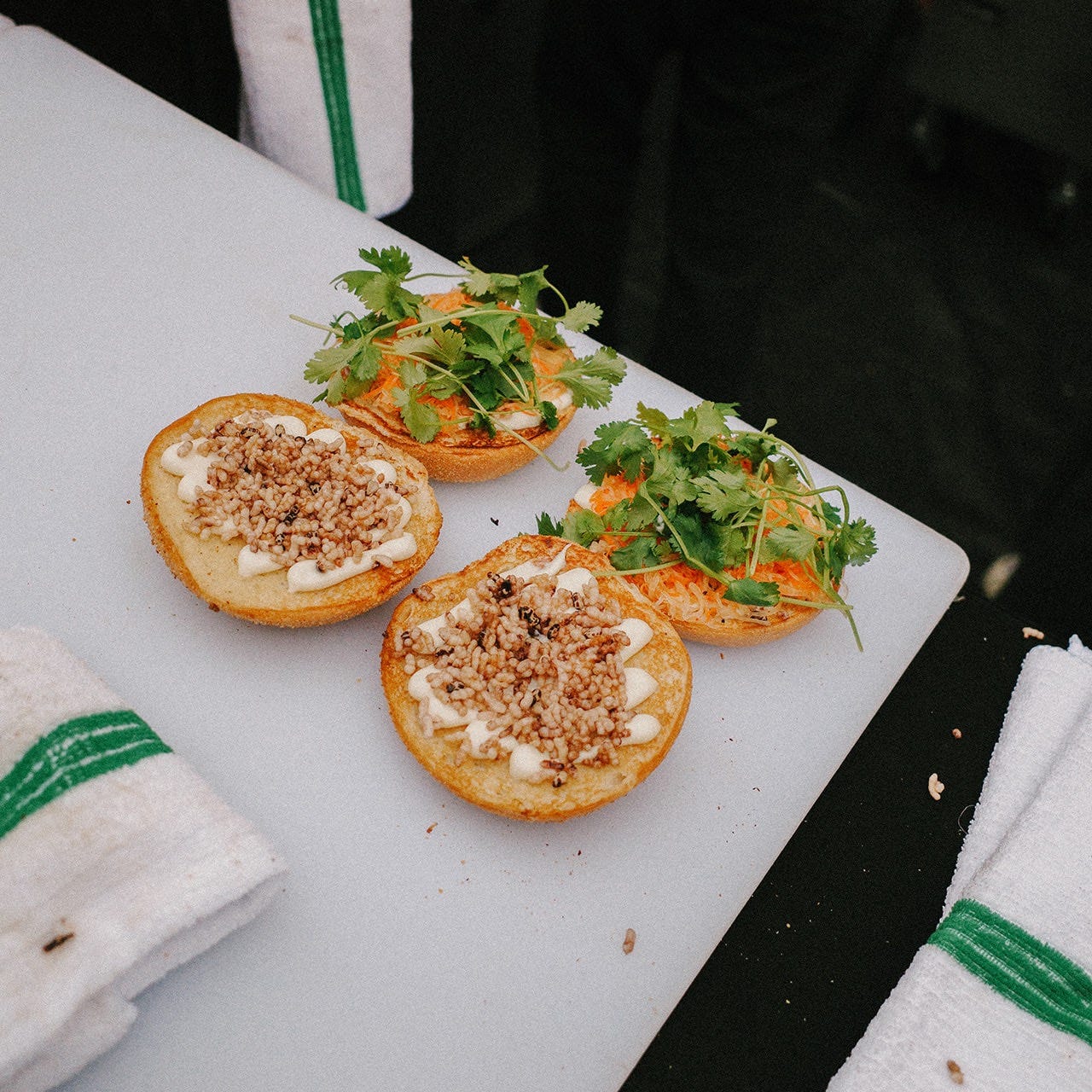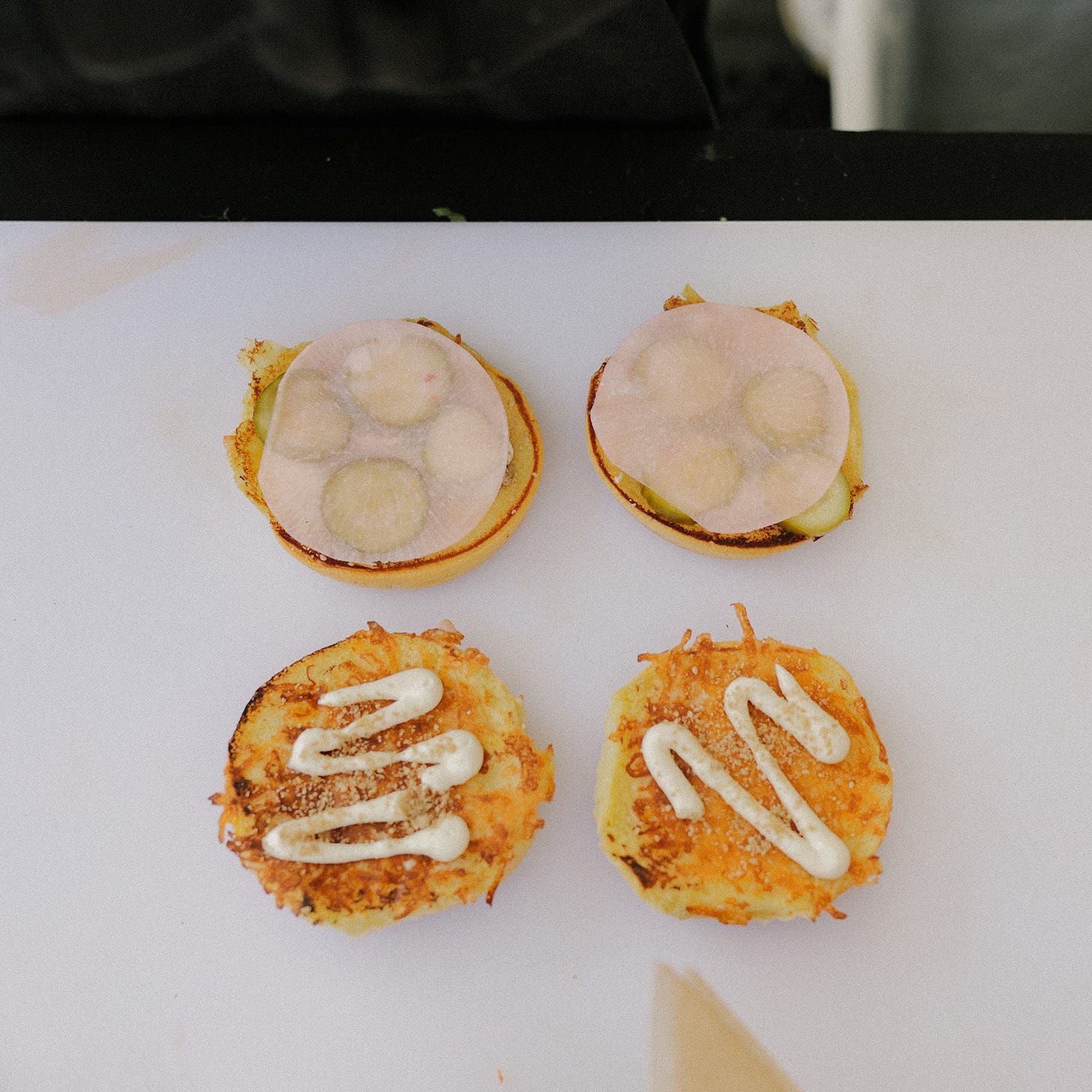Hey, hope you’re having a great week so far. And if it’s not so great… well, I hope you feel a bit better today.
We’re coming off the heels of a collaborative burger with Amboy last week, and a pizza special with our friend Joe Oh a few weeks ago at Smorgasburg.
It feels like a part of our brand that we were always insecure about, but are starting to find a bit more confidence in lately. So, this week I wanted to explore how we’ve created our specials, the inspiration/reasoning behind them, and how it relates to our ethos as a whole.
TL;DR - we don’t think our food is life-changing… we’re more interested in challenging ourselves to make familiar foods unique, and make dishes that people will associate with Softies.
Thanks so much for reading!
It’s just a burger…
Burgers are ubiquitous. They are literally everywhere, and every consumer has their favorite. In California, In-N-Out is the rightful king - it’s hard to compete with their affordability, accessibility, and consistency.
Sam and I knew a few things when we started Softies: that we are not chefs and wouldn’t act like we are, and that burgers are hard to “improve,” but we wanted to try making them different.
So, we broke it down into its components. A burger (and even a sandwich) is bun, meat, cheese, sauce, toppings.
Could we make or find a better bun than Martin’s? Probably not. Should we use a custom burger blend? Maybe, but that would cost a lot (we’ll explore food costs in its own post). Cheese?? American cheese just works.
We were left to play with sauce and toppings. Most burgers have a standard classic sauce with a mayo/ketchup/mustard base; what if we messed with sweetness, acidity, heat, and then experimented with different textures with toppings?
“The green one”
This is how Sam brought up his Aji Verde sauce, inspired by Mario’s Peruvian. He’d mainly made it to pair with breakfast burritos, but it checked the boxes of what we wanted: an acidic, garlicky, herby sauce, paired with pickled jalapeños for some spice.
We quickly found that it made our guests turn their heads and say, I’ve never tried a burger like this before.
Early on, and still to this day, it didn’t matter to us whether it became someone’s favorite burger - we just felt proud that we’d created something different.
(I would like to stop here for a moment and say, it’s pronounced ah-hee, not ah-jee.)
For the culture
In hindsight, Sam and I actually became “cooks” when we added a really important layer to our existing formula: how can we begin incorporating Asian culture/stories into our food, without being tacky?
The “tacky” part was really important to us, and created some hesitancy. Korean food is well-known to an extent, but its “billboard” dishes are a bit overdone at this point. We didn’t want to be the assholes who threw bulgogi on a burger, or do a Korean Fried Chicken sandwich just because it’s popular. And, for the love of God, no ramen burgers.
So we began referencing our favorite bites growing up, and then working backwards to see how we can turn our memories into a food that resembled a burger/sandwich:
Let’s make a bossam-inspired dish that reminds us of Kobawoo, with sous vide pork belly (meat), kimchi jam (topping), perilla and scallion (topping), and sesame mayo (sauce).
And after that, what if we replace a fried onion with fried enoki mushrooms (topping), and then have a really acidic yuzu mayo (sauce) and pickled red onion (topping) to balance out the richness?
Perfect is the enemy of good
I think our first couple dishes were a bit lucky, because there was nothing at stake. No one knew who we were, and frankly, barely anyone knows even now. But after people started to post about our food (it’s really the scariest thing ever), we put a lot of pressure on ourselves to keep one-upping what we’d done, which we now know is a long journey to nowhere.
We started to be a lot more picky with our ideas, and had a few (really) bad R&D sessions that hurt our confidence. We were trying too hard to be perfect, but we had to remind ourselves of the first common ground we had: hey, we’re not chefs, and we’re not trying to be, remember?
I’ve learned over time that no idea is bad if it’s just in your head. We have to keep trying things out, and let the dish and our taste buds tell us that it’s not good. But often times, we find our doubt preventing us from even trying.
As we kept exercising that muscle of putting an idea on a plate, we started to get more confident in failing, and a bit better at translating our stories, memories, and culture into dishes. In a way, we stopped caring about whether Eater would write about our food, and more about whether we were staying true to what we wanted to eat. The point of Softies was never to be the best; we just wanted to bring something new to the table.
Dude, let’s make our version of Domino’s sausage mushroom pie. Sean had the brilliant idea of brushing Lao Gan Ma on the crust, as an homage to Domino’s garlic butter:
“No One Does it Like Softies” (thanks Chelsea..)
As we continue to dream about what we want our brand to be one day, our food is becoming a bigger part of our identity. At first we just wanted to make a decent burger; now, we want to use its template to tell the story of who we are. We’ve never been, and never will be interested in making the best food you’ve ever tasted.
John Mayer once said (yea I’m quoting John Mayer so what??) - writer’s block is when the writer and the listener don’t agree with each other.
In a sense, the progression of our dishes shows us that we are getting better at listening before speaking. We’re more dialed into the food that we want to make, and these days we keep thinking about our pasts.
We are remembering which foods made us happy as kids, the dishes our moms used to make, listening, listening, listening… and hopefully, we’re able to speak through our food, and create something that makes us, and you, feel heard and seen.
Thanks,
J









